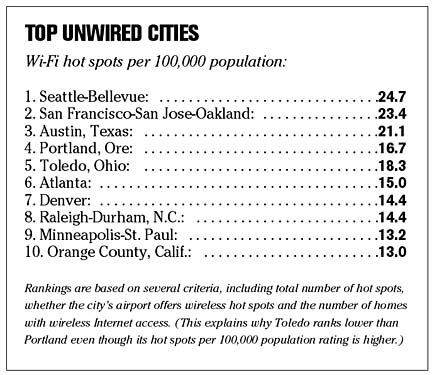Isles off pace
for wireless Internet
A national survey finds Honolulu
moving relatively slowly on Wi-Fi tech
In what could be a sign that Honolulu is failing to keep pace with the mainland, the city dropped 60 places in an annual survey released today that measures wireless Internet access by locale.
After placing 13th nationally last year in Intel Corp.'s annual Most Unwired City survey, Honolulu dropped to 73rd this year.
"It's not bad news because everybody on our list, everybody has large growth across the board," said Bert Sperling, founder of the research firm Sperling's Best Places and a co-author of the study. "It's just that there are other places that are moving faster than Honolulu."
Last year's survey said Honolulu had 22 wireless Internet access points; that number had grown to 53 this year, Sperling said.
"That's on the low end of the growth we see," Sperling said. "Some places had as many as five times what they had before."
In proportion to its population, the Honolulu area's number of wireless "hot spots" also was middling, breaking down to 5.8 per 100,000 people. That was considerably below the average of the top 100 cities in the survey, which was 9.2 per 100,000.

Rankings were based on several criteria, including the total number of hot spots, whether a city's airport has hot spots, the number of free hot spots and the percentage of homes with wireless networks.
Seattle led the survey with 24.7 hot spots per 100,000 people, Sperling said. Rounding out the top 10 were the San Francisco Bay area; Austin, Texas; Portland, Ore.; Toledo, Ohio; Atlanta; Denver; Raleigh-Durham, N.C.; Minneapolis-St. Paul; and Orange County, Calif.
The survey results come as Honolulu business and civic leaders are attempting to sort out several thorny issues involving Wi-Fi coverage in Honolulu, particularly in Waikiki. Wi-Fi technology uses low-power radio transmitters to link laptop computers and other devices to the Internet.
Largely unregulated and relatively inexpensive to set up, Wi-Fi systems have emerged in a patchwork around town, in hotels, coffeehouses, restaurants and shopping malls. Some areas are clogged with Wi-Fi transmitters, creating what some users say is a confusion of traffic and occasional interference. Other areas, meanwhile, have little or no service.
Enterprise Honolulu, a nonprofit economic development organization, has begun working with executives from the tourism and technology industries to resolve these issues and create what supporters say will be an umbrella of coverage from Honolulu Airport to Diamond Head.
"This shows that our timing is right and that we need to get our act together and move forward," said John Strom, vice president of business development and technology for Enterprise Honolulu, which is helping to establish the Hawaii Wireless Council. "This shows that we are moving down the right path."
The unwired-cities survey was based on market data obtained from national Wi-Fi service providers and online directories of Wi-Fi hot spots, Sperling said. Sperling acknowledged that this approach was far from perfect. Some hot spots, such as ones in the lobby of the Outrigger Canoe Club near Diamond Head and near the food court of Kahala Mall, did not appear to be captured in the survey, Sperling said.
"This is why I think that there's a lot more hot spots out there than there are reported," he said.
Still, Sperling defended the survey as a fair account of how places are developing.
Some local executives were more critical of the methodology. Pat Bustamante, president and chief operating officer of Pacific LightNet Inc., said his firm has set up transmitters to cover much of the city and is testing the system before offering it to customers, who could use the service for a fee. Such a system would not necessarily show up in the type of survey conducted by Sperling and Intel, Bustamante said.
"Very few in Hawaii show up on that," he said.
Josh Beil, vice president of business development and co-founder of Skywave Broadband Inc. of Honolulu, said his firm is establishing systems similar to Pacific LightNet's.
"You're not going to see one of our outdoor industrial transmitters posted on one of these Web sites that they're looking at because we're not just serving a cafe; we're serving this several-block radius," Beil said.
Skywave Broadband has more than tripled its coverage area in the past six months, Beil said.
Others were less critical of the results.
Nam Vu, vice president and chief technology officer of Internet service provider ShakaNet Inc., said one reason for Honolulu's poor showing could be that major retail chains, such as McDonald's Corp., have been aggressively rolling out Wi-Fi hot spots at their mainland locations but have been slower to do so in Hawaii.
"As far as being able to say, 'I've got 100 cafes here where I can connect to the Internet,' we're behind other cities," he said.
E-mail to City Desk
[News] [Business] [Features] [Sports] [Editorial] [Do It Electric!]
[Classified Ads] [Search] [Subscribe] [Info] [Letter to Editor]
[Feedback]
